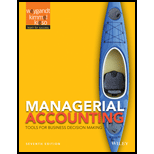
Break-Even Point:
The break-even point is a point where total cost incurred are the same as the total revenue earned. At the break-even point the profit will be zero. The break-even point is the point in the business where there is no loss and no gain.
To Determine: The Inn S’s break-even point in (1) number of rented rooms per month.
(2)
Break-Even Point:
The break-even point is a point where total cost incurred are the same as the total revenue earned. At the break-even point the profit will be zero. The break-even point is the point in the business where there is no loss and no gain.
To Determine: The Inn S’s break-even point in (1) number of rented rooms per month and (b) break-even point in dollars.
(b)
(1)
Margin of Safety: The margin of safety is that amount by which the actual value of the sales differs from the break-even sales value. This amount indicates that amount after which the business will reach the sales will reach the break-even point.
To Determine: The monthly margin of safety in dollars, if the inn plans on renting an average of 50 rooms per day.
(2)
Margin of Safety Ratio: The margin of safety depicted as the percentage of sales is called margin of safety ratio. The amount of margin of safety is divided by sales to determine this ratio.
To Determine: The margin of safety ratio, if the inn plans on renting an average of 50 rooms per day.
Want to see the full answer?
Check out a sample textbook solution
Chapter 6 Solutions
Managerial Accounting: Tools for Business Decision Making
- SUBJECT=FINANCIAL ACCOUNTING QUESTIONarrow_forwardIf there were 72,000 pounds of raw materials on hand on January 1, 196,000 pounds are desired for inventory at January 31, and 385,000 pounds are required for January production, how manypounds of raw materials should be purchased in January? A. 290,000 pounds. B. 509,000 pounds. C. 182,000 pounds. D. 337,000 pounds.arrow_forwardprovide solution with calculationarrow_forward
- What is the average collection period for accounts receivable?arrow_forwardCan you solve this financial accounting problem using accurate calculation methods?arrow_forwardRiver Co. reports the following for the year ended December 31: ⚫ Beginning balance of AOCI: $10,000 • Unrealized holding gain on available-for-sale securities (net of tax): $3,000 What is the ending AOCI balance?arrow_forward

 AccountingAccountingISBN:9781337272094Author:WARREN, Carl S., Reeve, James M., Duchac, Jonathan E.Publisher:Cengage Learning,
AccountingAccountingISBN:9781337272094Author:WARREN, Carl S., Reeve, James M., Duchac, Jonathan E.Publisher:Cengage Learning, Accounting Information SystemsAccountingISBN:9781337619202Author:Hall, James A.Publisher:Cengage Learning,
Accounting Information SystemsAccountingISBN:9781337619202Author:Hall, James A.Publisher:Cengage Learning, Horngren's Cost Accounting: A Managerial Emphasis...AccountingISBN:9780134475585Author:Srikant M. Datar, Madhav V. RajanPublisher:PEARSON
Horngren's Cost Accounting: A Managerial Emphasis...AccountingISBN:9780134475585Author:Srikant M. Datar, Madhav V. RajanPublisher:PEARSON Intermediate AccountingAccountingISBN:9781259722660Author:J. David Spiceland, Mark W. Nelson, Wayne M ThomasPublisher:McGraw-Hill Education
Intermediate AccountingAccountingISBN:9781259722660Author:J. David Spiceland, Mark W. Nelson, Wayne M ThomasPublisher:McGraw-Hill Education Financial and Managerial AccountingAccountingISBN:9781259726705Author:John J Wild, Ken W. Shaw, Barbara Chiappetta Fundamental Accounting PrinciplesPublisher:McGraw-Hill Education
Financial and Managerial AccountingAccountingISBN:9781259726705Author:John J Wild, Ken W. Shaw, Barbara Chiappetta Fundamental Accounting PrinciplesPublisher:McGraw-Hill Education





